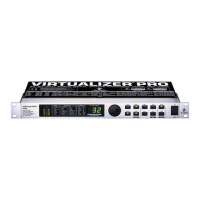
Do you have a question about the Behringer Virtualizer Pro DSP1024P and is the answer not in the manual?
Covers CAUTION, WARNING labels, and general safety advice for electrical shock and fire prevention.
Specific instructions on water, ventilation, heat, power source, grounding, cord protection, cleaning, and servicing.
Highlights dual engines, true stereo processing, and 24-bit AD/DA converters with oversampling.
Details 32 effects, 700 variations, and separate low/high EQ sections for sound customization.
Covers servo-balanced I/O, remote control software, and full MIDI capability.
Includes 100 user presets, LED metering, software upgradeability, and rugged construction.
Explains the no-compromise design, high-quality components, SMD technology, and ISO9000 manufacturing.
Covers checking packaging, rack unit size, cooling, power connection, and grounding.
Details balanced connections, MIDI link setup, and servo function for unbalanced signals.
Introduces the front panel elements including parameter keys, jog wheel, display, and power switch.
Explains the LED display, effect table, and the function of keys like EFFECT, VARIATION, ENGINE.
Details how to use the jog wheel for program selection and parameter editing.
Guides on selecting effects, variations, and editing parameters using ENGINE L/R and EDIT A/B.
Covers editing parameters for left/right channels, couple mode, EQ, IN/OUT, and STORE functions.
Explains how to save presets and details key combinations for factory reset, mix modes, and MIDI mode.
Details specific key combinations for reinitializing presets, activating mix modes, and entering MIDI mode.
Explains how Digital Signal Processors (DSP) compute effect algorithms and process audio signals.
Discusses influencing sound with parameters and how dual-mode effects split processing across channels.
Details reverb algorithms like Cathedral, Plate, Hall, Room, Studio, Concert, Stage, Vocal, and Percussion.
Describes Stereo Delay, Stereo Ping-Pong Echo, and Gated Reverb effects.
Details Vocal Distortion, Rotary Speaker simulation, and Vocoder effects.
Explains Pitch shifting, Flanger, and Chorus modulation effects.
Describes algorithms 20-24 that combine multiple effect types simultaneously.
Details algorithms 25-32 that split effects like pitch, flanger, chorus, tremolo, delay between left/right channels.
Visual representations of the signal flow for different algorithm types.
Instructions on how to select user-defined presets using the jog wheel.
Guides on using EFFECT, VARIATION, EDIT A/B, EQ LO/HI, and ENGINE keys for parameter adjustment.
Explains the process of saving modified presets, including overwriting and confirmation steps.
Details how to access the MIDI menu, select MIDI channels, and navigate MIDI parameters.
Configuring controller modes, program change transmission/reception, and store enable flag.
Explains System Exclusive functions for bulk data transfer (dump) for backup and restore.
Discusses the flexibility of the VIRTUALIZER PRO for various audio applications.
Emphasizes the importance of proper input and output level setting to avoid noise and distortion.
Guides on wiring and using the unit in a mixing console's aux send/return path for effects.
Illustrates how to connect the unit to a mixing console's insert points for single-channel processing.
Demonstrates using the Vocoder effect with a specific wiring setup for vocal modulation.
Explains how to insert the unit into guitar amp effects loops (preamp/power stage).
Details using MIDI footswitches and controllers for program changes and parameter control.
Describes integrating the unit into MIDI systems with sequencers or computers.
Instructions for archiving presets to external storage using MIDI system-exclusive data.
Explains how sound reflects in a room to create reverberation and spatial cues.
Discusses how the ear perceives room size and material characteristics through sound.
Describes natural reverberation chambers and their drawbacks like immobility and lack of parameter control.
Explains the principles and limitations of older spring and plate reverb technologies.
Highlights the benefits of digital reverb, including quality, parameter control, portability, and low maintenance.
Details mains connection, voltage selection, fuse replacement, and grounding requirements.
Explains servo-balanced inputs/outputs and the use of balanced vs. unbalanced connections.
Overview of the MIDI standard and specifications for MIDI cables and connectors.
Describes the purpose and functionality of the MIDI IN, THRU, and OUT ports.
Explains how to use the switch to adapt the unit to different operating levels.
A comprehensive table listing all effects and their associated parameters for VARIATION, EDIT A, EDIT B.
Provides specific delay time values and increments for presets 10 (Delay) and 11 (Echo).
A chart detailing transmitted and recognized MIDI messages and functions.
Maps specific MIDI control numbers to effect parameters and their value ranges.
Lists the default VARIATION, Edit A, and Edit B settings for all 32 effect algorithms.
Details input/output specifications, bandwidth, THD, crosstalk, and digital processing parameters.
Provides information on power supply voltages, fuse ratings, power consumption, dimensions, and weight.
Covers warranty card/online registration, 1-year warranty period, and exclusions.
Details the process for obtaining warranty service and applicable regulations.